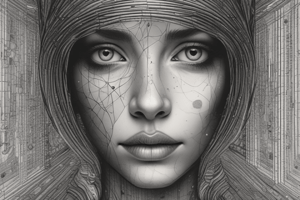Podcast
Questions and Answers
What does interposition suggest about the relative position of two overlapping objects?
What does interposition suggest about the relative position of two overlapping objects?
- The object that is obscuring appears farther away.
- The object in front is always moving.
- The object that is obscured is perceived as closer.
- The obscured object is seen as being farther away. (correct)
What role does relative height play in depth perception?
What role does relative height play in depth perception?
- Objects lower in the field are always considered closer.
- Objects higher in the field are seen as warmer.
- Height determines the color intensity of the objects.
- Height in the visual field provides a cue for perceived distance. (correct)
How does binocular disparity help in perceiving depth?
How does binocular disparity help in perceiving depth?
- It creates equal images in both eyes for depth estimation.
- It shows the exact location of nearby objects.
- It highlights the colors between distant objects.
- It combines images from both eyes into a single view. (correct)
What is the main difference between change blindness and inattentional blindness?
What is the main difference between change blindness and inattentional blindness?
Which scenario best illustrates the concept of greater disparity for closer objects?
Which scenario best illustrates the concept of greater disparity for closer objects?
What is the primary function of rods in the eye?
What is the primary function of rods in the eye?
Which statement accurately describes the fovea?
Which statement accurately describes the fovea?
What is the correct sequence of events from light entry to signal transmission in the eye?
What is the correct sequence of events from light entry to signal transmission in the eye?
How do cones enable color perception?
How do cones enable color perception?
What causes the blind spot in the retina?
What causes the blind spot in the retina?
Which phenomenon is described as the ability to perceive more than three colors?
Which phenomenon is described as the ability to perceive more than three colors?
What happens to the membrane potential of rods and cones when they detect light?
What happens to the membrane potential of rods and cones when they detect light?
What are S-cones primarily sensitive to in terms of light wavelengths?
What are S-cones primarily sensitive to in terms of light wavelengths?
What wavelength range do M-cones primarily respond to?
What wavelength range do M-cones primarily respond to?
Which of the following best exemplifies the principle of closure in Gestalt psychology?
Which of the following best exemplifies the principle of closure in Gestalt psychology?
In opponent process theory, selecting between which pairs of colors is emphasized?
In opponent process theory, selecting between which pairs of colors is emphasized?
What occurs during a color afterimage effect when looking at a colored object for a prolonged period?
What occurs during a color afterimage effect when looking at a colored object for a prolonged period?
How does the principle of simplicity (Prägnanz) affect visual perception?
How does the principle of simplicity (Prägnanz) affect visual perception?
Which of the following is a monocular depth cue?
Which of the following is a monocular depth cue?
What do feature detectors in the brain specifically respond to?
What do feature detectors in the brain specifically respond to?
Which principle states that elements that share similar characteristics are perceived as a group?
Which principle states that elements that share similar characteristics are perceived as a group?
Relative size perception hinges on what fundamental understanding?
Relative size perception hinges on what fundamental understanding?
What aspect defines figure-ground perception in visual processing?
What aspect defines figure-ground perception in visual processing?
Which of these is a characteristic of linear perspective?
Which of these is a characteristic of linear perspective?
What is the primary function of perceptual constancy?
What is the primary function of perceptual constancy?
How does texture gradient contribute to visual depth perception?
How does texture gradient contribute to visual depth perception?
What principle of Gestalt psychology promotes the idea that objects moving together form a single entity?
What principle of Gestalt psychology promotes the idea that objects moving together form a single entity?
What role do cones play in vision?
What role do cones play in vision?
Which of the following statements about accommodation is correct?
Which of the following statements about accommodation is correct?
Why do we experience a blind spot in our vision?
Why do we experience a blind spot in our vision?
How are neural signals generated in photoreceptors?
How are neural signals generated in photoreceptors?
What type of vision do rods primarily support?
What type of vision do rods primarily support?
What happens when light strikes photoreceptors in the retina?
What happens when light strikes photoreceptors in the retina?
What is the fovea's primary function in vision?
What is the fovea's primary function in vision?
Which type of cones respond to medium wavelengths of light?
Which type of cones respond to medium wavelengths of light?
How do humans perceive a wider range of colors beyond the inherent limitations of three cone types?
How do humans perceive a wider range of colors beyond the inherent limitations of three cone types?
What is a color afterimage and why does it occur?
What is a color afterimage and why does it occur?
Which visual phenomenon occurs due to the fatigue of photoreceptors after prolonged fixation on a colored object?
Which visual phenomenon occurs due to the fatigue of photoreceptors after prolonged fixation on a colored object?
Which principle suggests that we perceive competing visual stimuli as a singular object when they share direction and movement?
Which principle suggests that we perceive competing visual stimuli as a singular object when they share direction and movement?
How does the linear perspective cue contribute to depth perception?
How does the linear perspective cue contribute to depth perception?
Which depth cue relies on the observation that familiar objects appear smaller as their distance increases?
Which depth cue relies on the observation that familiar objects appear smaller as their distance increases?
What principle of Gestalt psychology allows us to perceive incomplete shapes as whole figures?
What principle of Gestalt psychology allows us to perceive incomplete shapes as whole figures?
Which visual processing theory encompasses both the trichromatic theory and the opponent process theory?
Which visual processing theory encompasses both the trichromatic theory and the opponent process theory?
What role do feature detectors play in the visual processing of stimuli?
What role do feature detectors play in the visual processing of stimuli?
Which Gestalt principle states that elements that are near each other tend to be grouped together?
Which Gestalt principle states that elements that are near each other tend to be grouped together?
What does the feature detector in the brain NOT respond to?
What does the feature detector in the brain NOT respond to?
In perceptual constancy, how do we maintain the perception of an object's size despite changes in distance?
In perceptual constancy, how do we maintain the perception of an object's size despite changes in distance?
What does binocular disparity primarily allow the brain to compute?
What does binocular disparity primarily allow the brain to compute?
How does interposition contribute to depth perception?
How does interposition contribute to depth perception?
What effect does relative height have on the perception of objects?
What effect does relative height have on the perception of objects?
Which statement best describes change blindness?
Which statement best describes change blindness?
What does greater disparity in binocular vision indicate?
What does greater disparity in binocular vision indicate?
What aspect of depth perception is stereopsis primarily concerned with?
What aspect of depth perception is stereopsis primarily concerned with?
How is inattentional blindness defined?
How is inattentional blindness defined?
What role does the position of an object play in relative height perception?
What role does the position of an object play in relative height perception?
Which of the following describes a key difference between change blindness and inattentional blindness?
Which of the following describes a key difference between change blindness and inattentional blindness?
What visual cue would typically suggest that an object is farther away?
What visual cue would typically suggest that an object is farther away?
Flashcards
Accommodation (Eye)
Accommodation (Eye)
The eye adjusting its lens shape to focus light on the retina for clear vision at different distances
Rods vs. Cones
Rods vs. Cones
Rods: Low-light, no color; Cones: Bright light, color vision
Fovea
Fovea
Area on retina with highest visual acuity, densely packed with cones, sharp central vision.
Transduction (Vision)
Transduction (Vision)
Signup and view all the flashcards
Blind Spot
Blind Spot
Signup and view all the flashcards
S-cones
S-cones
Signup and view all the flashcards
Color Perception (Beyond 3 Cones)
Color Perception (Beyond 3 Cones)
Signup and view all the flashcards
Color Afterimage
Color Afterimage
Signup and view all the flashcards
Interposition
Interposition
Signup and view all the flashcards
Relative Height
Relative Height
Signup and view all the flashcards
Binocular Disparity
Binocular Disparity
Signup and view all the flashcards
Change Blindness
Change Blindness
Signup and view all the flashcards
Inattentional Blindness
Inattentional Blindness
Signup and view all the flashcards
M-cones
M-cones
Signup and view all the flashcards
L-cones
L-cones
Signup and view all the flashcards
Trichromatic color vision
Trichromatic color vision
Signup and view all the flashcards
Color mixing
Color mixing
Signup and view all the flashcards
Opponent-process theory
Opponent-process theory
Signup and view all the flashcards
Color afterimage
Color afterimage
Signup and view all the flashcards
Feature detectors
Feature detectors
Signup and view all the flashcards
Perceptual constancy
Perceptual constancy
Signup and view all the flashcards
Gestalt psychology
Gestalt psychology
Signup and view all the flashcards
Simplicity (Prägnanz)
Simplicity (Prägnanz)
Signup and view all the flashcards
Perceptual Grouping Rules
Perceptual Grouping Rules
Signup and view all the flashcards
Figure-ground
Figure-ground
Signup and view all the flashcards
Monocular depth cues
Monocular depth cues
Signup and view all the flashcards
Relative Size
Relative Size
Signup and view all the flashcards
Linear Perspective
Linear Perspective
Signup and view all the flashcards
Accommodation (Eye)
Accommodation (Eye)
Signup and view all the flashcards
Rods vs. Cones
Rods vs. Cones
Signup and view all the flashcards
Fovea
Fovea
Signup and view all the flashcards
Transduction (Vision)
Transduction (Vision)
Signup and view all the flashcards
Blind Spot
Blind Spot
Signup and view all the flashcards
S-cones
S-cones
Signup and view all the flashcards
Color Perception (Beyond 3 Cones)
Color Perception (Beyond 3 Cones)
Signup and view all the flashcards
Color Afterimage
Color Afterimage
Signup and view all the flashcards
Cone types
Cone types
Signup and view all the flashcards
Photoreceptor activation
Photoreceptor activation
Signup and view all the flashcards
M-cones
M-cones
Signup and view all the flashcards
L-cones
L-cones
Signup and view all the flashcards
Trichromatic color vision
Trichromatic color vision
Signup and view all the flashcards
Color mixing
Color mixing
Signup and view all the flashcards
Opponent-process theory
Opponent-process theory
Signup and view all the flashcards
Color afterimage
Color afterimage
Signup and view all the flashcards
Feature detectors
Feature detectors
Signup and view all the flashcards
Perceptual constancy
Perceptual constancy
Signup and view all the flashcards
Relative size
Relative size
Signup and view all the flashcards
Linear perspective
Linear perspective
Signup and view all the flashcards
Interposition
Interposition
Signup and view all the flashcards
Relative Height
Relative Height
Signup and view all the flashcards
Binocular Disparity
Binocular Disparity
Signup and view all the flashcards
Change Blindness
Change Blindness
Signup and view all the flashcards
Inattentional Blindness
Inattentional Blindness
Signup and view all the flashcards
Depth Perception
Depth Perception
Signup and view all the flashcards
Closer Objects
Closer Objects
Signup and view all the flashcards
Slightly Different Views
Slightly Different Views
Signup and view all the flashcards
Greater Disparity
Greater Disparity
Signup and view all the flashcards
Stereopsis
Stereopsis
Signup and view all the flashcards




